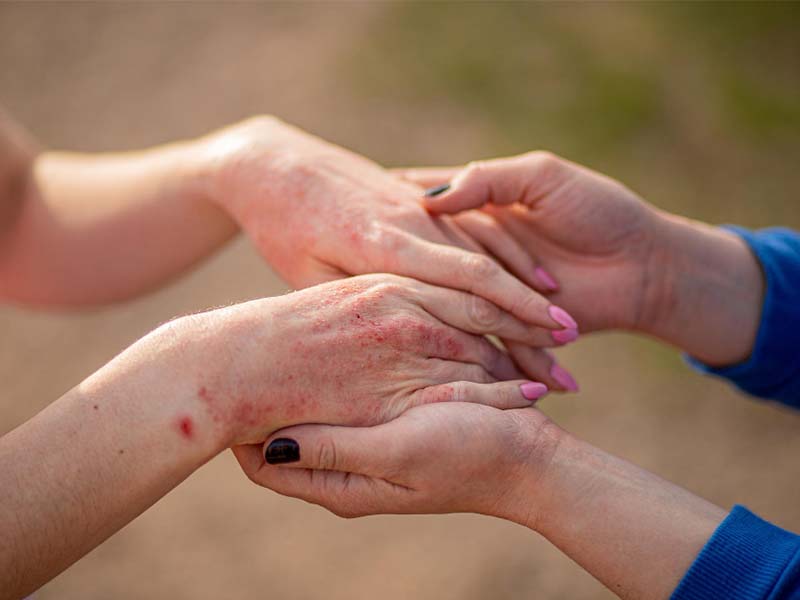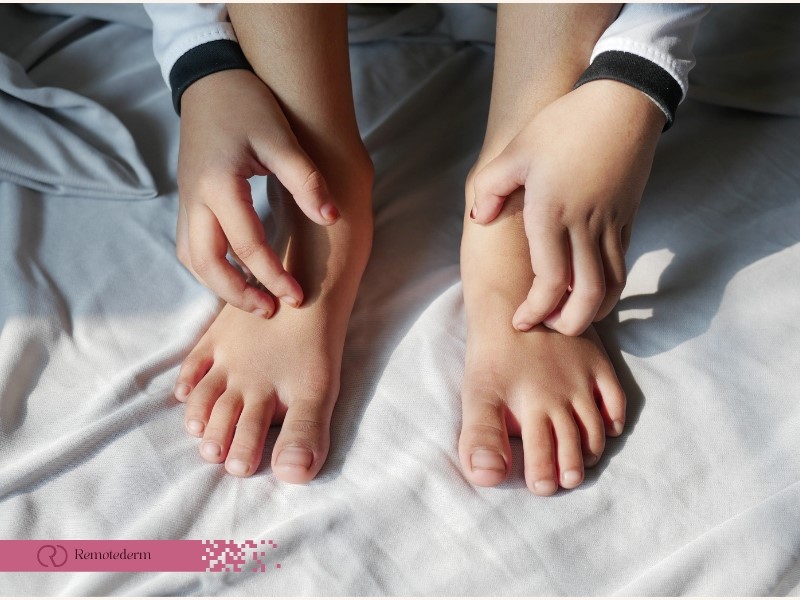Skin rash can be a frustrating and uncomfortable condition that appears on the skin in various forms. It can be caused by a wide range of factors, such as allergies, infections, environmental factors, stress, and genetic factors. Face rash, in particular, can lead to physical discomfort and emotional distress, affecting a person’s quality of life. However, most skin rashes can be effectively treated and managed with proper care and treatment. In this article, we will explore the most common types of skin rash, their causes, and treatment options available to manage this condition.
Types of Skin Rash
There are many types of skin rash, and each one has its own unique characteristics. Here are some of the most common types of skin rash:
- Eczema: Dry, itchy, and inflamed skin are symptoms of this chronic skin condition. Although it can happen to adults, children experience it the most frequently. It is not contagious and is manageable with the right care and treatment.
- Contact dermatitis: Contact dermatitis is a type of skin rash that occurs when the skin comes into contact with an irritant or allergen. It can cause redness, itching, and blisters. Common causes of contact dermatitis include poison ivy, nickel, fragrances, and certain types of soaps and cleaning products.
- Psoriasis: Psoriasis is a skin condition that causes red, scaly patches of skin. The elbows, knees, and scalp are the most commonly affected areas. An overactive immune system causes this condition, which can be triggered by stress, infections, and other factors.
- Hives: Hives are a type of skin rash that is characterized by raised, itchy, and red welts on the skin. They can be caused by allergies or other factors, such as stress, infections, or medications. Hives usually go away on their own within a few days, but they can be treated with antihistamines and other medications.
- Rosacea: Rosacea is another one of chronic skin diseases that causes redness, bumps, and pimples on the face. Adults over the age of 30 are most prone to it. Certain foods, alcohol, stress, and other factors can all trigger Rosacea. Rosacea has no cure, but it can be controlled with proper treatment and lifestyle changes.

Face Rash
Face rash refers to any type of skin rash that appears on the face. Identical to akin rashes, face tash can be caused by a variety of factors, including allergies, infections, and skin conditions.
The symptoms of a face rash can vary depending on the underlying cause. Some common symptoms of face rash include redness, itching, swelling, and bumps or blisters on the skin. The discomfort caused by a face rash can range from mild to severe, depending on the severity of the rash and the individual’s tolerance for discomfort.

In addition to physical discomfort, a face rash can also cause emotional distress. It can be embarrassing to have a rash on the face, especially if it is visible to others. This can lead to feelings of self-consciousness, anxiety, and even depression.
The discomfort and emotional distress caused by a face rash can impact a person’s daily life, making it difficult to focus on work or other activities. It is important to seek medical attention if a face rash is causing significant discomfort or affecting quality of life. With proper treatment and management, most face rashes can be effectively controlled and prevented from recurring.
Skin Rash Causes
Skin rash can be a frustrating and uncomfortable condition, and it can be caused by a variety of factors. Here are some of the most common causes of skin rash:
- Allergies: Skin rash can be caused by an allergic reaction to certain foods, medications, or other substances. Allergic reactions can cause the body to release histamines, which can cause redness, swelling, and itching on the skin.
- Infections: Skin rash can be caused by infections such as fungal infections, bacterial infections, and viral infections. These types of infections can cause the skin to become inflamed, itchy, and painful.
- Environmental factors: Skin rash can also be caused by exposure to certain environmental factors, such as heat, cold, or sunlight. For example, exposure to extreme heat can cause heat rash, which is characterized by small red bumps on the skin.
- Stress: Stress can also play a role in the development or worsening of skin rash. Stress can weaken the immune system and make it more difficult for the body to fight off infections, which can lead to skin rash.
- Genetic factors: Some people may be more prone to skin rash due to their genetic makeup. Certain genetic factors can make the skin more sensitive to certain irritants, making it more likely that they will develop a skin rash.

To effectively treat and manage skin rash, it is crucial to determine its underlying cause. It is advised to seek medical advice from a skin dermatologist if you have a persistent or severe skin rash.
Skin Rashes Treatment
The treatment of skin rash varies depending on the underlying cause of the rash and its severity. Mild cases of skin rash can often be treated with over-the-counter creams and lotions, while more severe cases may require prescription medications. Here are some common treatment options:
- Topical creams: Topical creams such as corticosteroids and antihistamines can be used to reduce inflammation and itching. Some common topical creams used to treat skin rash include hydrocortisone, calamine lotion, and aloe vera gel.
- Oral medications: Oral medications such as antihistamines and antibiotics may be prescribed for more severe cases of skin rash. Antihistamines can help to reduce itching and inflammation, while antibiotics can be used to treat bacterial infections.
- Moisturizers: Moisturizers can be used to keep the skin hydrated and reduce itching. Moisturizers that contain ceramides, urea, or glycerin can be especially helpful in treating skin rash.
- Avoiding triggers: If the skin rash is caused by an allergen or irritant, avoiding the trigger can help to prevent the rash from recurring. For example, if the rash is caused by exposure to poison ivy, avoiding contact with the plant can help to prevent further outbreaks.

In addition to these treatment options, lifestyle changes can also be helpful in managing skin rash. These may include:
● Wearing loose-fitting clothing to avoid irritation of the skin.
● Using mild, fragrance-free soaps and detergents to avoid skin irritation.
● Taking cool baths or showers to soothe the skin.
● Avoiding scratching the rash, as this can cause further irritation and may lead to infection.
● Drinking lots of water to keep the skin hydrated.
Remember to seek medical attention right away if the skin rash is severe or is accompanied by other symptoms like a fever or trouble breathing.
Prevention of Skin Rash
Skin rash can be uncomfortable and irritating, but there are steps you can take to prevent it from occurring. Here are some tips for preventing skin rash:
1. Avoid triggers: If you know what triggers your skin rash, try to avoid those triggers. Common triggers can include:
○ Certain foods or medications
○ Exposure to certain chemicals or irritants
○ Extreme temperatures
○ Stress or anxiety
2. Practice good hygiene: Keeping your skin clean can help to prevent skin rash. Here are some recommendations for maintaining good hygiene:
○ Take a shower or bath regularly
○ Use mild soap and warm water to wash your skin
○ Dry your skin thoroughly after bathing
○ Use a clean towel and change it frequently

3. Wear protective clothing: If you are exposed to environmental factors such as heat or sunlight, wear protective clothing. This can include:
○ Wearing long sleeves and pants
○ Wearing a hat to protect your face and scalp
○ Using an umbrella or other shade cover
4. Use a moisturizer: Keeping your skin hydrated can help to prevent skin rash. Here are some tips for using moisturizer:
○ Find a moisturizer that’s suitable for your skin type.
○ Apply moisturizer after bathing or showering, when your skin is still damp
○ Reapply moisturizer throughout the day, as needed
By following these prevention tips, you can help to reduce your risk of developing a skin rash. If you do develop a rash, it’s important to seek medical attention to determine the cause and receive appropriate treatment.
Final Thoughts
In conclusion, skin rashes can be a source of discomfort, embarrassment, and emotional distress. It is essential to identify the underlying cause of a skin rash to treat it effectively. There are various types of skin rashes, including eczema, contact dermatitis, psoriasis, hives, and rosacea, among others. Skin rashes can be caused by allergies, infections, environmental factors, stress, and genetic factors. Treatment options vary depending on the severity of the rash and its underlying cause, and they may include topical creams, oral medications, and lifestyle changes.

If you have a persistent or severe skin rash, it is advised to seek medical advice from a healthcare provider. Remotederm offers online dermatology consultation to help diagnose and treat skin rashes effectively from the comfort of your home. Don’t hesitate to seek medical attention if you need it, as proper treatment and management can effectively control and prevent skin rashes from recurring.
FAQs
1. What should Ido if I have a persistent or severe skin rash?
It is advised to seek medical advice from a healthcare provider if you have a persistent or severe skin rash.
2. Are there any home remedies for treating skin rashes?
There are several home remedies that can help soothe and alleviate the symptoms of skin rashes, including applying a cool compress, taking an oatmeal bath, and using aloe vera or coconut oil.
3. When should I seek medical attention for a skin rash?
You should seek medical attention for a skin rash if it is severe, spreading rapidly, or accompanied by other symptoms such as fever, chills, or difficulty breathing.
4. How do I know if I have a skin rash?
Skin rashes can manifest in various ways, such as redness, bumps, blisters, or itchiness. If you notice any unusual changes or discomfort on your skin, it’s best to consult with a healthcare provider.
5. Can skin rashes be contagious?
Some skin rashes can be contagious, such as those caused by infections like ringworm or scabies. It’s essential to take proper precautions to prevent the spread of the rash.
6. How long does a skin rash last?
The duration of a skin rash can vary depending on its cause and severity. Mild rashes may go away on their own within a few days, while chronic conditions like eczema may require ongoing management.
